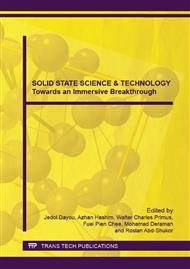[1]
S. Siebentritt, Why are kesterite solar cells not 20% efficient?, Thin Solid Films. 535 (2013) 1-4.
DOI: 10.1016/j.tsf.2012.12.089
Google Scholar
[2]
S. R. Hall, J. T. Szymanski and J. M. Stewart, Kesterite, Cu2(Zn, Fe)SnS4 and stannite, Cu2(Fe, Zn)SnS4 structurally similar but distinct minerals, The Canadian Mineralogist 16 (1978) 131-137.
DOI: 10.1063/1.4862030
Google Scholar
[3]
S. Schorr, The crystal structure of kesterite type compounds: A neutron and X-ray diffraction study, Solar Energy Materials & Solar Cells. 95 (2011) 1482-1488.
DOI: 10.1016/j.solmat.2011.01.002
Google Scholar
[4]
Zhao, Z., Ma, C., Cao, Y., Yi, J., He, X., Qiu, J., Electronic structure and optical properties of wurtzite-kesterite Cu2ZnSnS4. Physics Letters A377 (2012) 417-422.
DOI: 10.1016/j.physleta.2012.11.057
Google Scholar
[5]
S. Siebentritt and S. Schorr. Kesterites—a challenging material for solar cells, Progress in Photovoltaics: Research and Applications. 20 (2012) 512-519.
DOI: 10.1002/pip.2156
Google Scholar
[6]
S. S. Mali, B. M. Patil, C. A. Betty, P. N. Bhosale, Y. W. Oh, S. R. Jadkar, R. S. Devan, Y. -R. Ma, P. S. Patil, Novel synthesis of kesterite Cu2ZnSnS4 nanoflakes by successive ionic layer adsorption and reaction technique: Characterization and application, Electrochimica Acta. 66 (2012).
DOI: 10.1016/j.electacta.2012.01.079
Google Scholar
[7]
S. S. Swami, A. Kumar, V. Dutta, Deposition of Kesterite Cu2ZnSnS4(CZTS) Thin Films by Spin Coating Technique for Solar Cell Application, Energy Procedia 33 (2013) 198-202.
DOI: 10.1016/j.egypro.2013.05.058
Google Scholar
[8]
M. Meng, L. Wan, P. Zou, S. Miao, J. Xu, Cu2ZnSnSe4 thin films prepared by selenization of one-step electrochemically deposited Cu-Zn-Sn-Se precursors, Applied Surface Science. 273 (2013) 613–616.
DOI: 10.1016/j.apsusc.2013.02.088
Google Scholar
[9]
S. Schorr, M. Tovar, H. J. Hoebler, H. W. Schock, Structure and phase relations in the 2(CuInS2)–Cu2ZnSnS4 solid solution system. Thin Solid Films, 517(7) (2009) 2508-2510.
DOI: 10.1016/j.tsf.2008.11.032
Google Scholar
[10]
X. He, H. Shen, First-principles study of elastic and thermo-physical properties of kesterite-type Cu2ZnSnS4, Physica B: Condensed Matter. 406(24) (2011) 4604-4607.
DOI: 10.1016/j.physb.2011.09.035
Google Scholar
[11]
D. Huang, C. Persson, Band gap change induced by defect complexes in Cu2ZnSnS4, Thin Solid Films 535, (2013) 265–269.
DOI: 10.1016/j.tsf.2012.10.030
Google Scholar
[12]
H. Zhao, C. Persson, Optical properties of Cu(In, Ga)Se2and Cu2ZnSn(S, Se)4, Thin Solid Films. 519(21), (2011) 7508-7512.
DOI: 10.1016/j.tsf.2010.12.217
Google Scholar
[13]
S. Chen, J. H. Yang, X. G. Gong, A. Walsh, S. H. Wei, Intrinsic point defects and complexes in the quaternary kesterite semiconductor Cu2ZnSnS4, Physical Review B. 81(24) (2010) 245204.
Google Scholar
[14]
S. Chen, A. Walsh, Y. Luo, J. H. Yang, X. G. Gong, S. H. Wei, Wurtzite-derived polytypes of kesterite and stannite quaternary chalcogenide semiconductors, Physical Review B. 82(19) (2010) 195203.
DOI: 10.1103/physrevb.82.195203
Google Scholar
[15]
S. Chen, A. Walsh, J. H. Yang, X. G. Gong, L. Sun, P. X. Yang, J. H. Chu, S. H. Wei, Compositional dependence of structural and electronic properties of Cu2ZnSn(S, Se)4 alloys for thin film solar cells. Physical Review B, 83(12) (2011) 125201.
Google Scholar
[16]
T. A. Oliveira, J. Coutinho, V. J. B. Torres, Born effective charges of Cu2ZnSnS4 quaternary compound: First principles calculations, Thin Solid Films. 535 (2012) 311 – 313.
DOI: 10.1016/j.tsf.2012.10.115
Google Scholar
[17]
S. Botti, D. Kammerlander, M. A. Marques, Band structures of Cu2ZnSnS4 and Cu2ZnSnSe4 from many-body methods, Applied Physics Letters. 98 (2011) 241915.
DOI: 10.1063/1.3600060
Google Scholar
[18]
N. B. M. Amiri, A. Postnikov, Secondary phase Cu2SnSe3 vs. kesterite Cu2ZnSnSe4: Similarities and differences in lattice vibration modes, Journal of Applied Physics. 112 (2012) 033719.
DOI: 10.1063/1.4745894
Google Scholar
[19]
T. Maeda, S. Nakamura, T. Wada, First principles calculations of defect formation in in-free photovoltaic semiconductors Cu2ZnSnS4 and Cu2ZnSnSe4. Japanese Journal of Applied Physics, 50 (2011) 04DP07.
DOI: 10.1143/jjap.50.04dp07
Google Scholar
[20]
S. Chen, A. Walsh, X. G. Gong, S. H. Wei, Classification of Lattice Defects in the Kesterite Cu2ZnSnS4 and Cu2ZnSnSe4 Earth‐Abundant Solar Cell Absorbers. Advanced Materials. 25 (2013) 1522–1539.
DOI: 10.1002/adma.201203146
Google Scholar
[21]
A. Walsh, S. Chen, S. H. Wei, X. G. Gong, Kesterite Thin‐Film Solar Cells: Advances in Materials Modelling of Cu2ZnSnS4, Advanced Energy Materials. 2(4) (2012) 400-409.
DOI: 10.1002/aenm.201100630
Google Scholar
[22]
N. A. Zabidi, A. N. Rosli, H. A. Kassim, K. N. Shrivastava. Density Functional Theory Adsorption of Atoms on Cytosine, Malaysian Journal of Science, 29(1) (2010) 64-72.
DOI: 10.22452/mjs.vol29no1.10
Google Scholar
[23]
A. N. Rosli, H. A. Kassim, K. N. Shrivastava, DFT Calculation of Vibrations in the Clusters of Zinc and Oxygen Atoms, Sains Malaysiana. 42(5) (2013) 649-654.
Google Scholar
[24]
A. N. Rosli, H. A. Kassim, K. N. Shrivastava, Clusters of GaAs Prepared by Quantum Mechanical DFT and the Nanowire Raman Spectra, Sains Malaysiana. 42(12) (2013) 1811 – 1814.
Google Scholar


